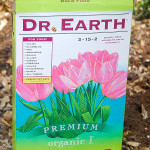I wandered lonely as a cloud, That floats on high o’er vales and hills, When all at once I saw a crowd, A host, of golden daffodils ~ William Wordsworth

Dutch Master Daffodils in Bloom
In the hopes of having something other than bare ground, and some spindly fruit trees to look at in the orchard in spring, we’ve started planting our bulbs on the hillside. Well aware that we have a gazillion grazing gophers nearby, we needed to find bulbs that might NOT be considered haute cuisine by these furry food grinders.
As a rule, I try not to impulse-buy anything for the garden, but when my local garden center had 50 daffodil bulbs for $20, I couldn’t resist. When you have a lot of ground to cover, finding economical ways to fill the spaces in the garden is a must. Starting plants from seed, propagating cuttings in greenhouses, and buying bulbs in bulk that will naturally multiply themselves over time, all help to keep the budget in check. However, no matter how good a deal you find, it’s all a waste if everything you plant turns into gopher food, isn’t it?

Just one of numerous gophers lurking near the orchard
The area we’re planting will be fenced soon, hopefully keeping the deer, and bunnies at bay. Gophers, moles, voles, mice, and their ilk however are less easy to exclude, and their palates are not particularly discriminating…as evidenced by the $600 of damage done to one of our cars this past weekend by a rampaging rodent nibbling on the wiring harness. But I digress.
On the bulb front it seems there is some hope that we will see flowers in the spring…as the Sunset Western Garden Book states the following in regards to Narcissus (Daffodils, Narcissus, and Jonquils):
“These plants do not require summer watering (but will take it), need only infrequent division (and will even survive without it), and are totally unappetizing to gophers and deer“.
Perhaps we should abandon the orchard, vineyard, and gardens, and start a daffodil farm!? Although I don’t believe everything I read, I was so excited to read that, I went back to the garden center with a grin on my face as wide as the Cheshire Cat’s, and I’m now planting 150 “Dutch Master” daffodil bulbs in the garden! It’s really my way of thumbing my nose at the gophers that so far have eaten everything from our California poppies to Yarrow in the past couple of years.

Grape Hyacinth (Muscari latifolium)
In addition to the daffodils, another reportedly deer and rodent resistant bulb is the grape hyacinth. I have a particular fondness for the grape hyacinth, as my grandfather had them planted in his garden in England, and each year they’d reliably bloom alongside the tulips and daffodils. I’ve managed to procure 90 grape hyacinth bulbs (Muscari latifolium), and am planting those alongside the daffodils, crossing my fingers that both will pop up in spring…preferably where I planted them.
So, with no less than 240 bulbs to plant, while standing on a slope, clearly I would have been lucky to get them planted before next year if I had to dig each hole by hand. I’m a big proponent of using the right tool for the job, so I broke out the cordless drill, fitted it with a bulb planting auger, and thus far am planting at a leisurely rate of 40 bulbs an hour.
To be honest, I don’t know how on earth I survived without this simple tool before now. It not only saves time, but saves the lower back too!
Ultimately my goal will be to get the daffodils and grape hyacinth to naturalize across the orchard slope. I don’t want them to look like I intentionally put them there, so I’m planting them in drifts, randomly across the hill. I drill a dozen or so holes at once, drop some organic fertilizer in the bottom of each hole, set the bulbs upright, and cover them with soil, tucking them in for the winter.
Hopefully, if all goes well, the daffodils and grape hyacinths will both help to transform the hillside by spring, providing an early blaze of spring color just before the orchard is in full bloom. Although our fruit trees will eventually become quite large, they’re decidious, so the flowers should receive ample sunlight before the trees leaf out.
With the planting almost done, now we just have to wait and see what spring will bring…












